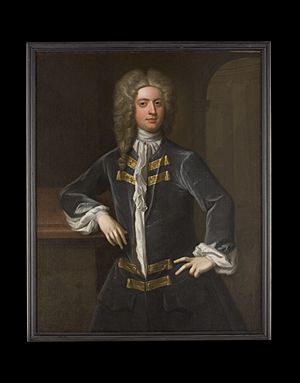Sir Wilfrid Lawson, 3rd Baronet, of Isell facts for kids
Quick facts for kids
Wilfrid Lawson
|
|
|---|---|
 |
|
| 3rd Baronet of Isell | |
| In office 1704–1737 |
|
| Member of the British Parliament for Boroughbridge |
|
| In office 1718–1722 |
|
| Member of the British Parliament for Cockermouth |
|
| In office 1722–1737 |
|
| Personal details | |
| Born | 1697 |
| Died | 13 July 1737 |
| Spouse | Elizabeth Lucy Mordaunt |
| Children | 4 |
| Parents |
|
| Alma mater |
|
Sir Wilfrid Lawson, 3rd Baronet of Isell, was an important British politician. He was born in 1697 and passed away on July 13, 1737. He served in the House of Commons, which is like a part of the government, from 1718 until his death. He was also a Fellow of the Royal Society, a group that promotes science.
Contents
Early Life and Family Background
Wilfrid Lawson was the son of Sir Wilfrid Lawson, 2nd Baronet, and Elizabeth Preston. His family lived in Cumbria, England. When his father passed away in 1704, young Wilfrid inherited the title of Baronet. This title meant he was part of a special group of people with a hereditary honor. He also inherited Isel Hall, the family home.
Education and Learning
Wilfrid went to Queen's College, Oxford, a famous university, in 1713. After that, in 1715, he began studying law at the Inner Temple. This was a place where people learned to become lawyers.
Starting His Political Journey
In 1717, Wilfrid Lawson tried to become a Member of Parliament (MP) for the Cockermouth area. The previous MP had left his job. There was a bit of a mix-up during the election. Two people, Lord Percy Seymour and Sir Wilfrid Lawson, were both declared winners.
Election Challenges
Both candidates complained about the election results. Lord Percy said Wilfrid was too young to be an MP, as he was not yet 21. Wilfrid, on the other hand, claimed there was unfairness in the election. Even though both complaints were later dropped, Wilfrid admitted to some issues. Because of this, Lord Percy became the MP for Cockermouth that time.
Serving in Parliament
In 1718, Wilfrid Lawson successfully became an MP for the Boroughbridge area. He gave his first speech on November 11. He supported the government's plans and voted for new laws. He also helped start the Royal Academy of Music. This was a London opera company that hired famous composers like Handel to create music.
Moving to Cockermouth
In 1722, Wilfrid Lawson was elected as the MP for Cockermouth, the area he had tried to represent earlier. He continued to serve as the MP for Cockermouth until he passed away.
Supporting the Government
For a while, Wilfrid supported the government's decisions. However, he later started to disagree with some of their plans. For example, in 1724, he supported a motion to reduce the number of soldiers. He also spoke out against certain financial decisions made by the government.
Challenging the Prime Minister
Wilfrid became a leading member of the opposition group. This group disagreed with the government, especially with the Prime Minister, Sir Robert Walpole. In 1733, Wilfrid asked for important documents related to issues with Spain. He managed to get his request approved, even though the Prime Minister was against it. In 1736, he supported a motion to change a law called the Test Act. In 1737, he spoke in favor of giving more money to the Prince of Wales.
Family and Legacy
Wilfrid Lawson married Elizabeth Lucy Mordaunt. They had two sons and two daughters. Sadly, both of his sons, Sir Wilfrid Lawson, 4th Baronet, and Sir Mordaunt Lawson, 5th Baronet, passed away when they were children. This meant that the family line of the Isel Lawsons ended.
A Daughter's Story
His eldest daughter, Elizabeth, who passed away in 1759, had an interesting story. She became a Maid of Honour to the Princess of Wales, a very important position. She was courted by General James Wolfe, a famous military hero. However, Elizabeth chose not to marry him. This story shows how influential and respected the Lawson family was.
Images for kids


